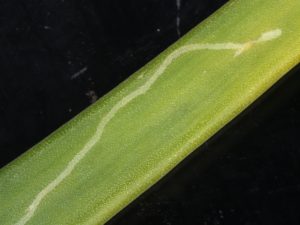Sweet Corn
The arrival of warmer temperatures should improve corn growth considerably. This same weather could bring on the first consistent European corn borer (ECB) catches, although this has not yet happened. No ECB were captured in blacklight traps this week. As the population develops, look for maps to be published in the weekly IPM Update. There were several corn earworm (CEW) captured in blacklights located in New Egypt, Folsom and Woodstown this past week, however these individuals are of little concern in the absence of silking sweet corn.
Cole Crops
IPM personnel continue to observe infestations of crucifer flea beetle. These beetles can build to high populations quickly, especially where wild mustard and related cruciferous weeds are common. Extreme feeding on small transplants can cause irreversible damage if not controlled promptly.
Imported cabbageworm butterflies (ICW) are active again now that daytime temperatures are rising. Egg laying is ongoing, and infestations of this pest will develop quickly now. Scout plantings weekly. Check 5 consecutive plants each in 10 random locations throughout the planting, paying particular attention to the innermost leaves where ICW often feed. Consider treating if caterpillars are found on 10% or more plants that are in the 0-9 true leaf stage. From 9-leaf to the early head stage (in broccoli, cauliflower and cabbage) infestations up to 20% may be tolerated. Once heads begin to form, a 5% threshold should be observed to protect the marketable portion of the plant. For leafy greens such as collards and kale, 10% plants infested is the threshold throughout.
Allium Leafminer ( ALM) Update
ALM adult catches on sticky cards placed in chive plantings in the central and northern counties appear to have peaked from April 17-26. Catches since then have declined dramatically, and have not rebounded. Catches on traps placed from Mercer through Morris County have captured no more than 2 ALM adults for the previous 7 days. Mines (see photo at right) caused by developing larvae should be noticeable on infested plants at this time.
Tomatoes
Aphid populations have begun to appear in high tunnel tomatoes. These pests often form colonies beneath the surface of leaves and near growing points on the plant. While the plants consist primarily of vegetative growth without fruit, aphids are largely an insignificant pest. If no broad spectrum insecticides are used on the plants, the aphids generally are decimated by predators and parasites before becoming an economic problem. Predators include syrphid (flower) fly maggots and ladybird beetles. When scouting, take note not just of the aphid populations, but of the presence of these predators. Their appearance is a sign that the aphid population could soon decline as long as predators are not disrupted. Should aphid populations increase to a degree that their droppings are accumulating on the surface of developing fruit, an insecticide that specifically targets these pests may be necessary. See the 2016-17 Commercial Vegetable Production Recommendations for materials that are labeled for aphid control in tomatoes. Avoid broad spectrum insecticide classes such as synthetic pyrethroids as much as possible. With warm temperatures now here, be watchful for the appearance of two-spotted spider mite (TSSM) infestations in the high tunnels. This pest is favored by high temperatures, and the lack of rain on tunnel-grown plants can allow TSSM populations to increase rapidly.
Pepper Weevil Update
Two pepper weevils (probably a male and female) were trapped in the Hammonton area outside of one of the processors. Nearby farms should be monitoring for the presence of weevils in their fields.


